If you buy through our links, we may earn an affiliate commission. This supports our mission to get more people active and outside.Learn about Outside Online's affiliate link policy
The 8 Best Sport Earbuds (Fall 2025): Tested and Reviewed

Our lead tester enjoying superior sound while hiking in Sedona with one of our best sport earbud picks. (Photo: Grace Palmer)
Table of Contents
When I was younger I had a high-adrenaline running playlist that I carefully curated to pump up my heart rate: Arctic Monkeys, Jay-Z, Rage Against the Machine. As my preference shifted toward podcasts, I seized the opportunity to explore ideas while chasing my weekly mileage goals. What remained constant was my appreciation for the best sports earbuds on the market. I’ve tested hundreds of pairs, ranging from wired to wireless, with features like active noise cancellation and customizable tap-activated controls. Here are the eight sport earbuds we were most impressed with, whether indoors or out, on land or in the water, on city sidewalks or remote trails.
Update October 2025: With the recent introduction of Apple’s AirPods Pro 3, our testers landed on a new all-around favorite for the best sport earbuds available. We chose three other new earbuds as best in their category and updated prices and availability on four that are still available and outstanding.
Best Sport Earbuds: At a Glance
- Best Sport Earbuds All-Around: Apple AirPods Pro 3 ($249)
- Killer Value: Back Bay FirstClass 50 ($40)
- Best Earbuds for Runners: Beats Powerbeats Pro 2 ($250)
- Best Open-Ear: Skullcandy Push 720 Open ($150)
- Best Headphones for Water: Shokz OpenSwim Pro ($180)
- Best Bass: Bose QuietComfort Ultra Earbuds (2nd Gen) ($299)
- Most Innovative: Denon PerL True Wireless Earbuds ($99)
- Best High-Fidelity: Bowers & Wilkins Pi8 ($499)
Best Sport Earbuds All-Around
Apple AirPods Pro 3
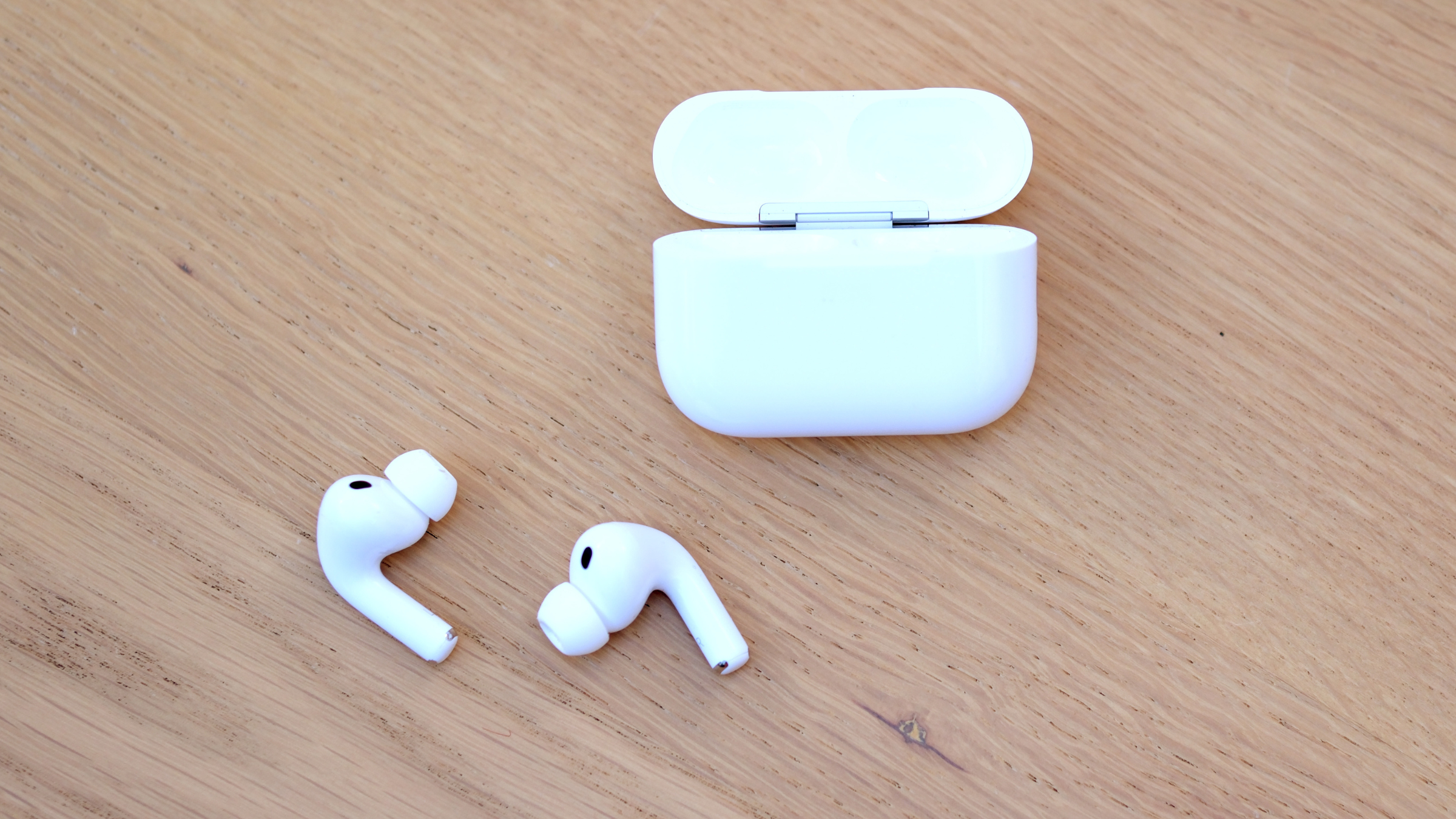
Pros and Cons
+ Sounds better than ever
+ Water protection and battery life improved
– Live translation still needs work
The AirPods Pro 3 pack an incredible amount of technology into a $250 item. In 2025, earbud audio quality has advanced so far in so many brands—like the Bose, Bowers & Wilkins, and Beats models in this review—that the tiebreaker for our test crew was the added features that Apple (of course) does better than anyone. Built around the supporting suite of iPhone, Mac, and Apple Watch, the bells and whistles in the AirPods can’t be matched.
A partial list of said bells and whistles: a hearing test, loud-sound reduction, conversation boost for noisy places, and a transparency mode that still sounds great and instantly mutes when you speak.
But let’s start with the music: Playing a track like Anderson .Paak and Hailee Steinfeld’s “Coast,” there’s a cleanness and momentum that makes it hard not to feel good. Testers said “their sound is solid and tasteful for a wide range of music, with crispy highs and emphatic lows,” though one cited a “muddy middle” and gave a slight acoustic edge to the Bose Quiet Comforts (see below).
One notable improvement here is the IP57 rating, a step up from IP54 on the Pro 2—in effect, this means going from splashproof to submersible for short periods. A lot has been made of the multiple eartips on this release, designed to dial in a perfect fit. While the fit test accessed on your iPhone is fun and possibly instructive, multiple ear tips have been included with nearly every new pair of earbuds in the past 10 years. (If you don’t believe me, look in my gear drawer.) All we’d say is that the fit on the Pro 3 is good—surprisingly stable during movement, and better than the Bose, but not as good for high-intensity workouts as the Beats Powerbeats Pro (our “Best Earbuds for Runners”). That said, props to Apple for making 10,000 ear scans to try to optimize fit for the most people possible.
Active noise canceling (ANC) has purportedly become twice as effective in this model vs. the Pro 2. Listening tests in noisy bars have not quite backed that up, but that’s fine: The Pro 2 was already among the best, and these do seem a bit more effective at drowning out ambient noise and leaving you alone in your sonic cave.
The AirPods Pros’ charging case—the smallest and most pocket-friendly of this bunch—can be tracked on your phone and made to beep when you’ve misplaced it. This feature has been a stress reliever more often than I would have guessed. Battery life has also been boosted, from six hours (with ANC turned on) to a substantial eight hours here.
The other big addition to the Pro 3 is live language translation. By holding down the buttons on both stems, you can listen to a foreign speaker and read a real-time transcription on your phone. Right now, it works in English, French, German, Portuguese, and Spanish, and by the end of 2025 Apple promises to add Italian, Japanese, Korean, and Chinese.
Our team didn’t get far with it: some didn’t have a new enough iPhone (15 Pro or beyond) to take advantage at all, and for those who did, it took some work to download the desired language to their phone. If your only reason for upgrading to the Pro 3 was this feature, hold off. It will take a while for this tech to be truly useful. But watch this space, because live translation is likely to be one of the most exciting things earbuds will do in the coming years. Along with companies like Viaim, whose Open Note is equipped for more than 100 languages, Apple and others should soon be making language barriers a thing of the past.
Killer Value
Back Bay FirstClass 50
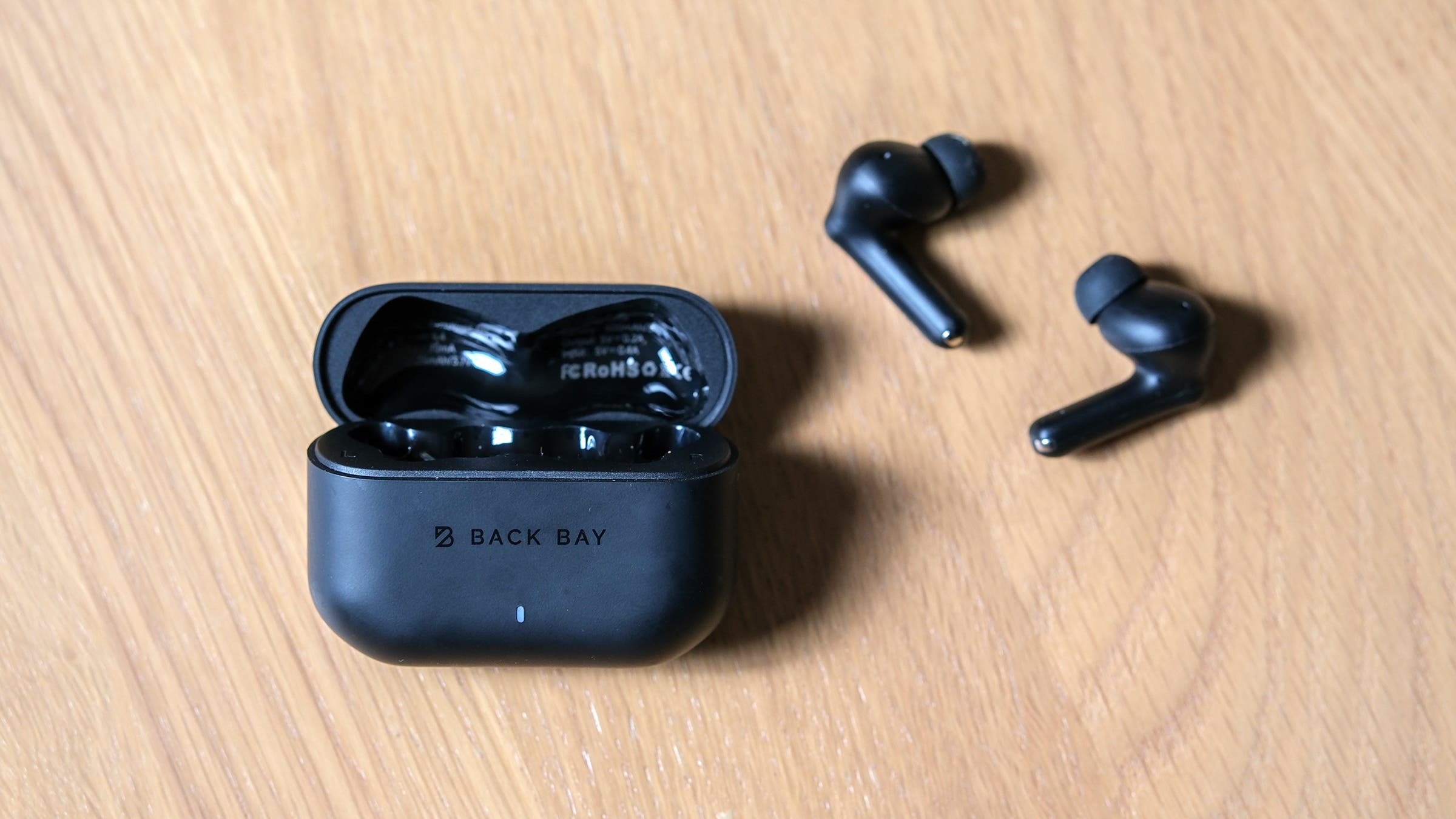
Pros and Cons
+ Excellent noise canceling
+ Robust sound quality
– Slipped out of some users’ ears
– Touch controls aren’t the most intuitive
“Seriously: $40,” said our Aspen-based tester. “That’s less than a hamburger in this town.” While we don’t envy those restaurant prices, we all concurred that the Back Bay FirstClass 50 is one of the best sport earbuds for the price.
Boston-based Back Bay has created something like a day-for-night version of Apple’s AirPods: similar size and shape but in black, and with sound quality that comes eerily close to that perennially pricey fave. Since Back Bay cuts out a lot of costs by selling straight to consumers, their quality products—all certified carbon-neutral, to boot—don’t bear any of the marks of cheapness, unlike many similarly priced items.
Even at the bargain price, they deliver excellent sound quality and also offer active noise canceling. Seriously: One itinerant tester said, “Sitting in the noisiest seat on the aircraft—aft of the wing, and in front of two worked-up toddlers—I could make it all disappear with a click.” The company claims these earbuds block 97% of noise. We’re not sure how that’s possible, but they do the job as well as almost anything we’ve put to the test for a fraction of the price.
While battery life is an average five hours per charge (with 25 hours overall in the case), they offer a 15-minute quick charge to add two hours of playtime. The IPX5 water protection keeps them going in a storm, and while the fit isn’t as secure as others in this review, they one-up AirPods in this regard by adding rubber tips to help them stay secure.
Best for Runners
Beats Powerbeats Pro 2
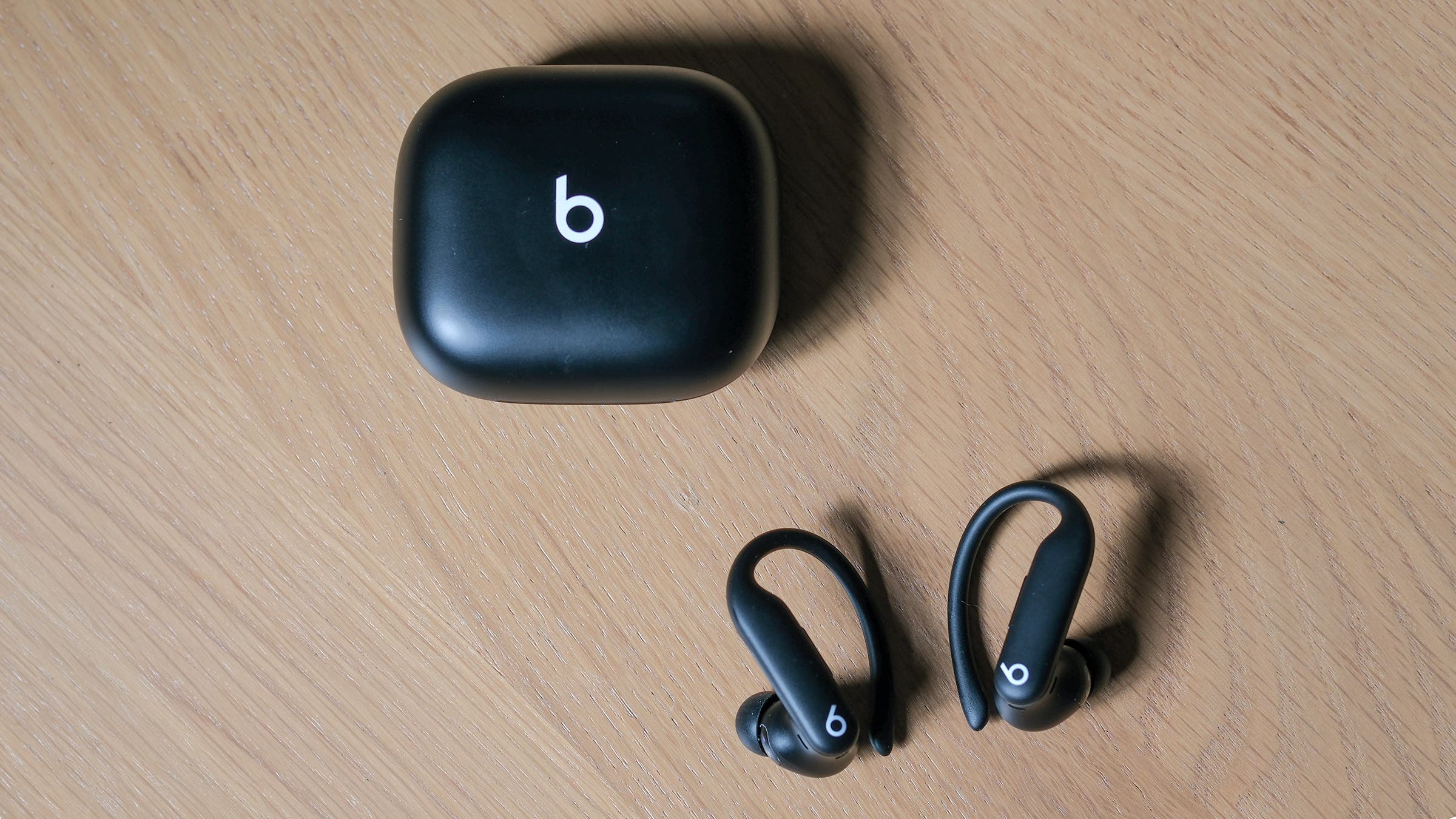
Pros and Cons
+ Secure fit and comfort
+ Push buttons that you control
– Too trebly at times
– Heart-rate device pairing takes some work
The second generation of the Powerbeats Pro is a big step up from the first, and it quickly gained go-to status for every member of our test team. “Actual buttons you can feel and click, paired with rich sound, comfy fit, and a microphone that canceled the noise of the windstorm I was walking through while talking on the phone? Wow,” enthused one tester.
This model is loaded with features not seen on the first—notably active noise cancellation (ANC) and heart-rate monitoring capability. Battery life is a superb 10 hours on a charge, which adds to their everyday-wear appeal. The case, which now allows wireless charging, supplies a total of 45 hours before you need a plug-in.
As with everything Beats (and parent company Apple), the acoustics shine: Adaptive EQ on the Pro 2 reads the environmental factors around you and adjusts the frequencies in your music for optimal sound. That sound is full and rich, without too much bass—but a bit too harsh on the treble end for some testers.
The ANC in the Pro 2 shows just how far that tech has come. “Noise canceling made the city disappear until I had to cross traffic, then—pop!—full awareness,” one tester noted. We also appreciated the push-button controls, which not only provide a satisfying haptic response so you know when the button has been pushed, but also eliminate accidental pauses when you brush your finger against the earbud (a huge annoyance for many users). The buttons also make it easy to toggle from one connected device to another without swiping to your Bluetooth controls, and they can even be pressed with a tilt against your shoulder, which comes in handy in the kitchen or whenever both hands are occupied.
The IPX4 rating stands up well to sweat and rain, and the lighter profile (vis a vis the first gen) and soft rubbery coating make them comfortable through long hours of use. The flexy ear hooks—one of the big attractions for any athlete—are extremely well designed, fitting each tester’s ears perfectly and not budging a millimeter during HIIT workouts. Even the new color palette is alluring, with new orange and purple options. All told, the Powerbeats Pro 2 represent the state of the art in active-user earbuds. As one tester reported, they “transition seamlessly from workout to travel to urban navigation.”
Best Open Ear
Skullcandy Push 720 Open
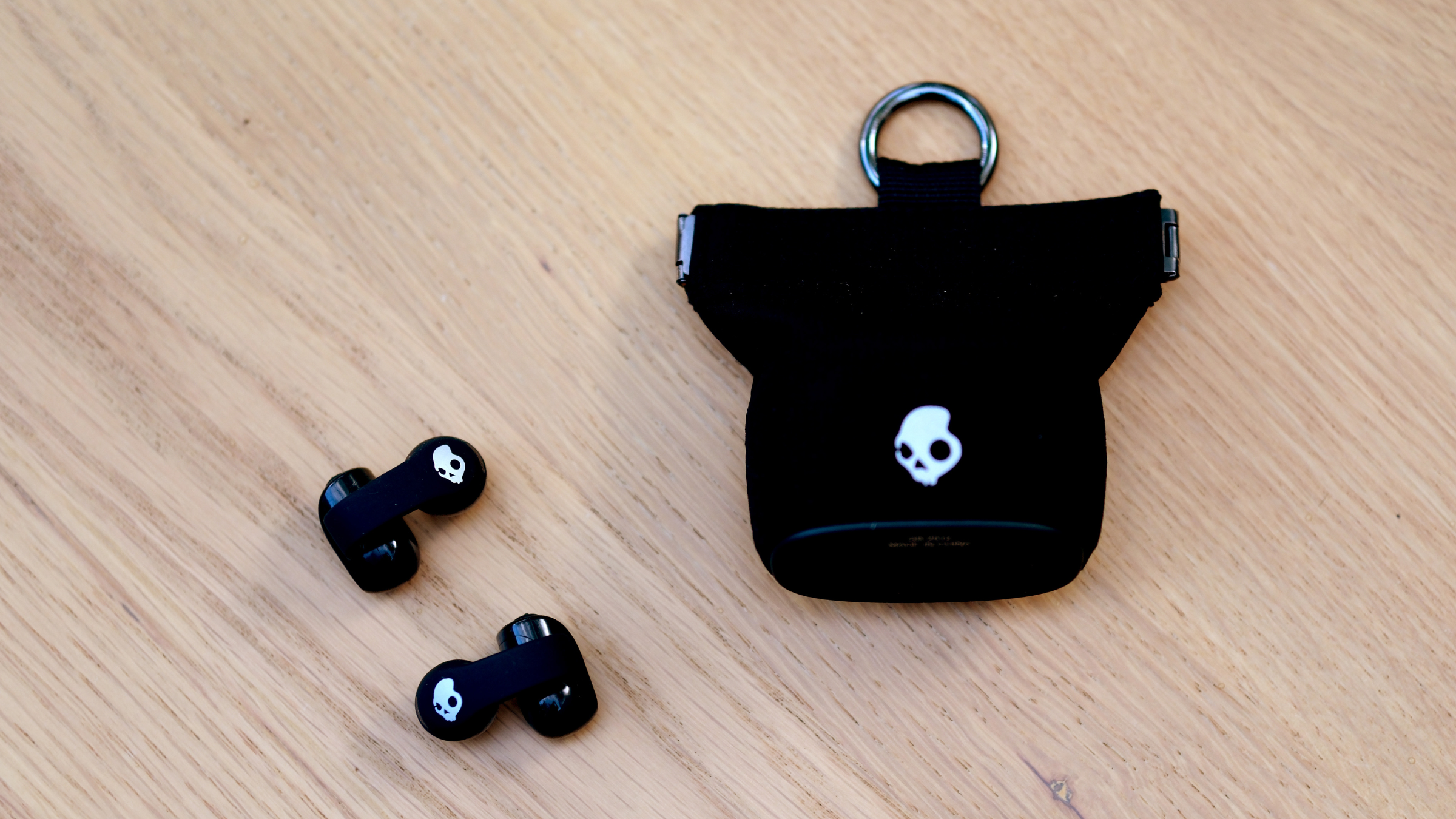
Pros and Cons
+ Great sound in an open design
+ Good old-fashioned push buttons
– Charging case hard to access
– Tend to fall off with vigorous activity
In two years’ time, I’ve evolved from being bewildered by open-ear designs to finding them okay for podcasts to actually liking them. The Push 720 Open has done a lot to convince me. This clip-on pair features a flexy silicone band that helps them grasp the side of your ear and hold a substantial speaker right at the entrance of your ear canal. All of our testers appreciated how much better they could hear with these versus comparable models. The sound can even be customized via the Skullcandy app, with EQ settings for Music, Podcasts, Bass Boost, and one customizable option. By leaving it on Bass Boost, for the first time ever, I’ve found an open-ear design that I actually use to listen to music, not just spoken words.
“Skullcandy again succeeds with a fun, solid charging case design,” one tester said, “this time a carrying pouch that can clip to a belt loop and could probably fit a house key and some lip balm.” The case can be plugged in or charged magnetically to provide 30 hours of total charge time—the buds will play for a slightly disappointing six hours per charge, but a 10-minute refresh adds two more hours. One word of warning on that marsupial case design: if you have large fingers, it can be difficult to reach down into the pouch.
The Push 720 Opens stand up well to moisture, with an IP67 rating, one of the highest in this year’s tests. Testers also appreciated the multipoint pairing, which allows them to be connected to your laptop and take a call on your phone without making any new connections. And the push button on top of each bud was loved by testers who are annoyed by the inadvertent pauses that touch controls can make. Both buttons can be programmed to perform various functions, the most fun of which is “Take Photo,” which lets you set up your phone or device and take a selfie remotely.
One rhetorical question arises here. This model has won me over because it delivers loud, clear sounds right into my ears without being in my ears. But does that very fact make the open design pointless? While streaming Leonard Cohen’s “The Future,” would I actually hear a maniacal mountain biker bearing down on me from behind? More testing may be called for …
But their solid, rich sound, a reasonable price, and a comfortable, surprisingly secure fit—“They even stayed in place while shooting hoops,” said one tester— make the Push 720 Open our new favorite in the very trendy open-ear style.
Best Headphones for Water
Shokz OpenSwim Pro
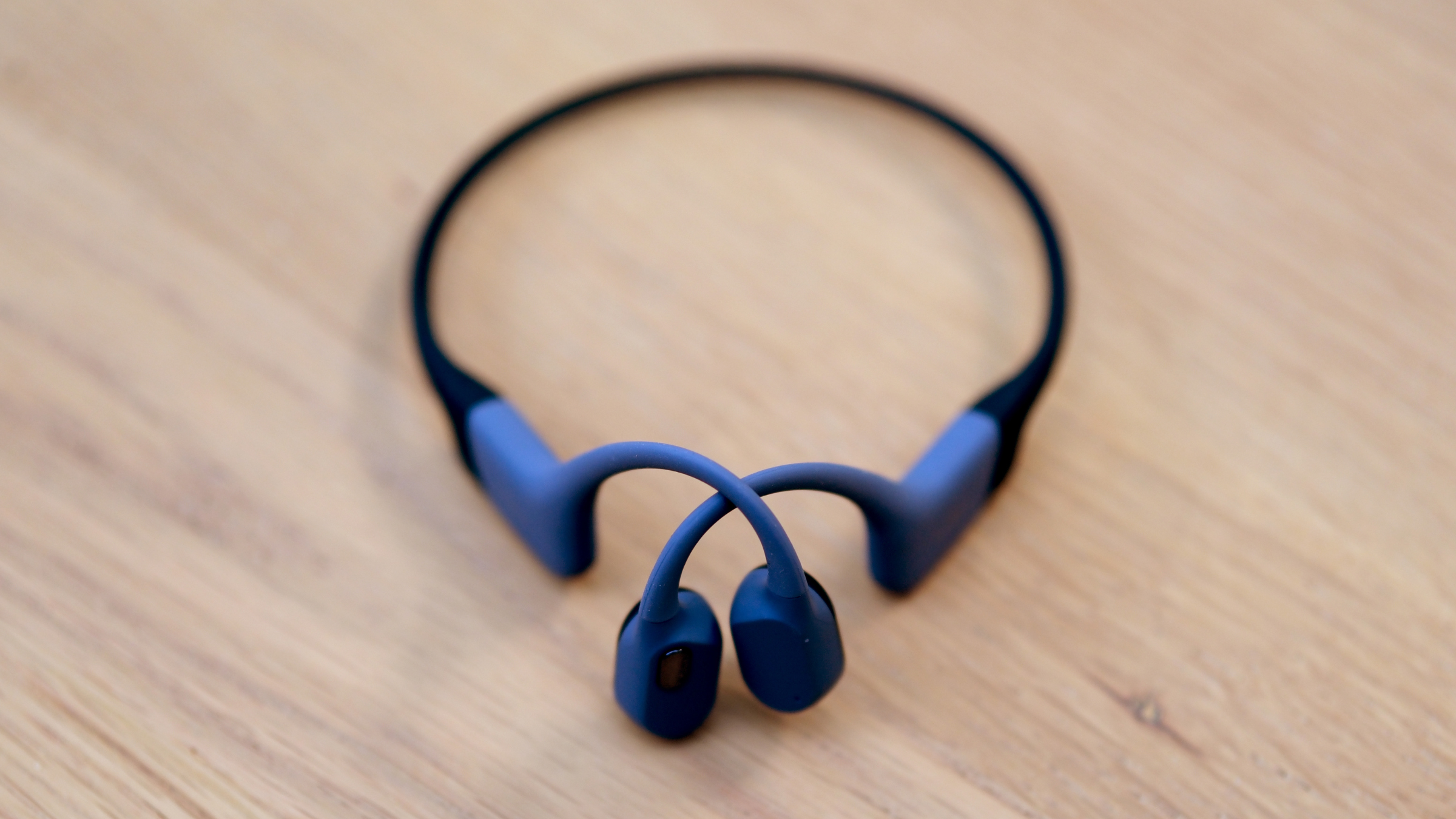
Pros and Cons
+ Excellent sound, anywhere
+ Intuitive controls
– Some find bone conduction ticklish
Have you harbored dreams—like our windsurfing test team member—of “turning sales meetings into sails meetings,” funneling techno into your auditory nerve while on your board, and then voice-commanding over to an incoming business call? After our aquaman put five different models of waterproof bone conduction headsets through this very drill on San Francisco Bay, the OpenSwim Pro emerged as the winner.
The latest earbuds from Shokz are a versatile piece of IP68 fully waterproof equipment, intended for anyone who loves water, even if they spend some time on land. Swimmers and snorkelers will want to store MP3 files right on the device—it holds up to 32GB—for completely submerged listening. Triathletes, runners, and bikers, as well as surfers who manage to stay above water, can use Bluetooth mode and carry their phone. This makes the OpenSwim Pro a Swiss Army knife of open-ear listening.
“When I’m sailing, I’m normally above the surface,” wrote our man on the Bay. “And these headphones do a surprisingly good job of staying connected to my phone while I’m out sailing. If I take a spill and go underwater, the music cuts out, but the moment I resurface, the headphones reconnect.”
Skeptics of bone conduction are not uncommon, and often justified: They can be ticklish at high volumes, a result of sending sound to your auditory nerve and not into your ear canal. While the test team had good results from other models like the Suunto Aqua and the much lower-priced Creative Outlier Free Pro, “the sound quality on this Shokz model is shockingly good,” said one. And if you go below the surface, the included earplugs neutralize water noise, making music sound surprisingly smooth, even at moderate volumes.
Above the surface, each user will want to try out different approaches. “My headphones have to compete with the roar of wind, waves, birds, boat traffic, and the whooping of whoever’s whizzing over the water nearby,” said our windsurfer. “I could use earplugs to block out the ambient noise and get even better sound, but I don’t want to be the cat who got run over by a cargo ship while listening to Yungblud’s latest hit.”
The OpenSwim Pro also scored points for features like the comfortable soft rubber cladding around the neckband, and they’re rated for nine hours of runtime in Bluetooth mode and six hours in MP3 mode.
This form factor still has room to improve, but Shokz has crafted a user-friendly and effective model for water lovers and triathletes. “Like a surfer or kayaker, we windsurfers have one thing in common: Our hands are busy,” said our board member. If I need to adjust the volume or pause my music, I usually have less than a half second to do it.” The location of the volume buttons on the right ear and play/pause on the left makes the OpenSwim Pro more intuitive than its competitors for quick actions, and these functions—as well as pulling up a name from contacts to dial—can also be activated via voice assistant. All of which will increase your odds of staying on your board.
Best Bass
Bose QuietComfort Ultra (2nd Gen)
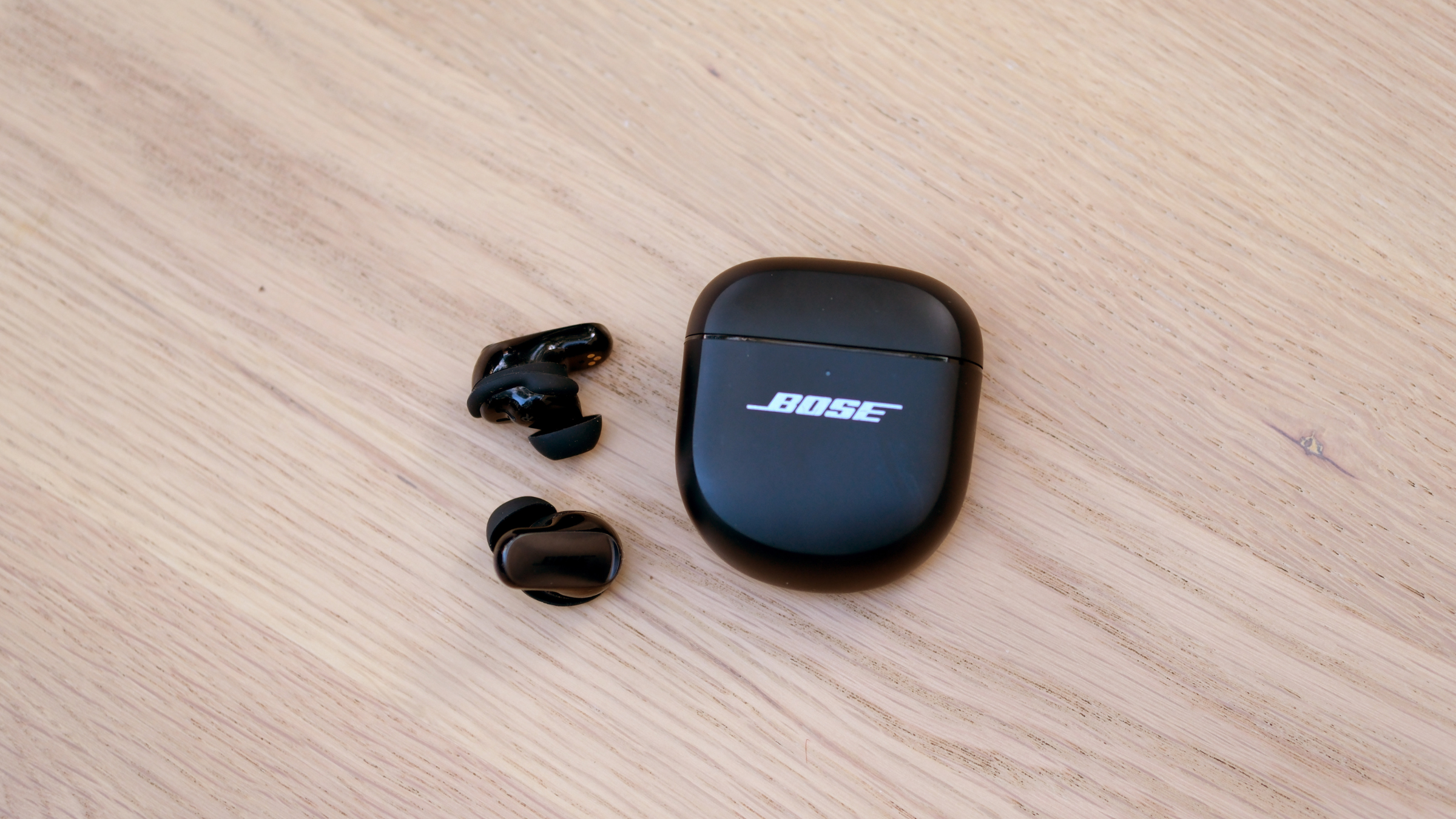
Pros and Cons
+ Rich, deep sound
+ Superb noise cancellation
– Shape is bulky, too large for some
When a particular audio feature jumps out at everyone, it means something. Reviewers described the bass in the QC Ultra with words like “heft” and “lift.” One raved, “Somehow maintains melodic lift even as it shakes your skull.” While Bose’s newest buds ran neck and neck with the AirPods Pro 3 for best all-around sound, their real wow factor lies in that deep, belly-soothing bass.
It’s also not as if the bass overwhelms the highs and lows, as can happen with cheaper bass-boosting models; on the contrary, more than one tester said they sound “crystalline.” Bose accomplishes this with the help of a tech called CustomTune that takes sonic measurements of your ears to find where your ear shape causes distortions and adjusts output so you’re listening to music the way it was intended to sound.
Then there’s Bose’s excellent active noise canceling, which one tester called “actually astonishing,” adding, “When I wore them on a flight, the crying babies and the engines disappeared.” Here the QC Ultras do outperform the AirPods Pro 3—the noisy A/C unit I’m sitting next to as I write this just completely faded to black. In addition to the common Quiet, Aware, and Immersion ANC modes, Bose lets you add several other options like Cinema, for sinking into your favorite blockbuster movie.
These also (like the Bowers & Wilkins below) offer Immersive Audio—in “Still” and “Motion” options—that moves the sound around so it seems to be occupying the space around you. Listening to podcasts, it’s as if different talkers are speaking from different locations. “The strings in a Tony Bennett song shimmer so much you can practically see the bow strings vibrate,” one reviewer said.
While the touch controls are useful, some testers found them finicky: “Once you’ve paused a track with the earbuds, frequently the only way to unpause it is to snap out of the moment and dig out your phone.” The QC Ultra has IPX4 water protection, making them fine in a drizzle, and plays for an average six hours per charge, with 18 more hours in the case.
But the “Comfort” part of their name is earned. Soft rubber eartips are backed up by a soft rubber outer ring that helps them maintain stability. Add their light weight and you’ll hardly know they’re there—but you’ll be glad they
Most Innovative
Denon PerL True Wireless Earbuds

Pros and Cons
+ Rich, dynamic sound
+ Impressive app
+ Customizable sound profile
– Chunky size
“Each product is hand-tuned by our sound master,” Denon says of the PerLs, and while we don’t know exactly what that means, it speaks to the Japanese DNA in these premium-sounding buds. Take the accompanying software, for instance: The first thing you do with these wireless buds is download an app that streams a series of sounds and frequencies into your ears to measure how you hear, then creates a personalized profile that transforms how good music sounds. It’s one of the best uses of a headphone app we’ve seen.
The PerLs came across as lively but not piercing on the high end, with realism and verve. There’s even a high-gain option on the app that boosts volume for quiet recordings, which one tester called “a welcome feature that I would love to see in a lot of sometimes anemic Bluetooth earbuds.” These capabilities are made possible by a series of ultra-sensitive microphones, which probably explains their rather enormous size—one reviewer called them “sharp-edged Alka-Seltzer tablet earbud bodies” and noted, “I had to remove the supplied fin attachment before these felt okay.”
Others liked the fit and found them great for running, where they kept the adrenaline flowing with some of the best full-on rocking-out sound in the test. “St. Vincent and Spoon sounded like I was listening to vinyl,” one tester said. The active noise cancellation is decent, the six hours of battery is average (with two more charges from the case), and an IPX4 rating means they can handle a light rain. Given the quality and attention to detail, we consider these a true bargain at $139 or less.
Best for Audiophiles
Bowers & Wilkins Pi8 In-Ear True Wireless Earbuds
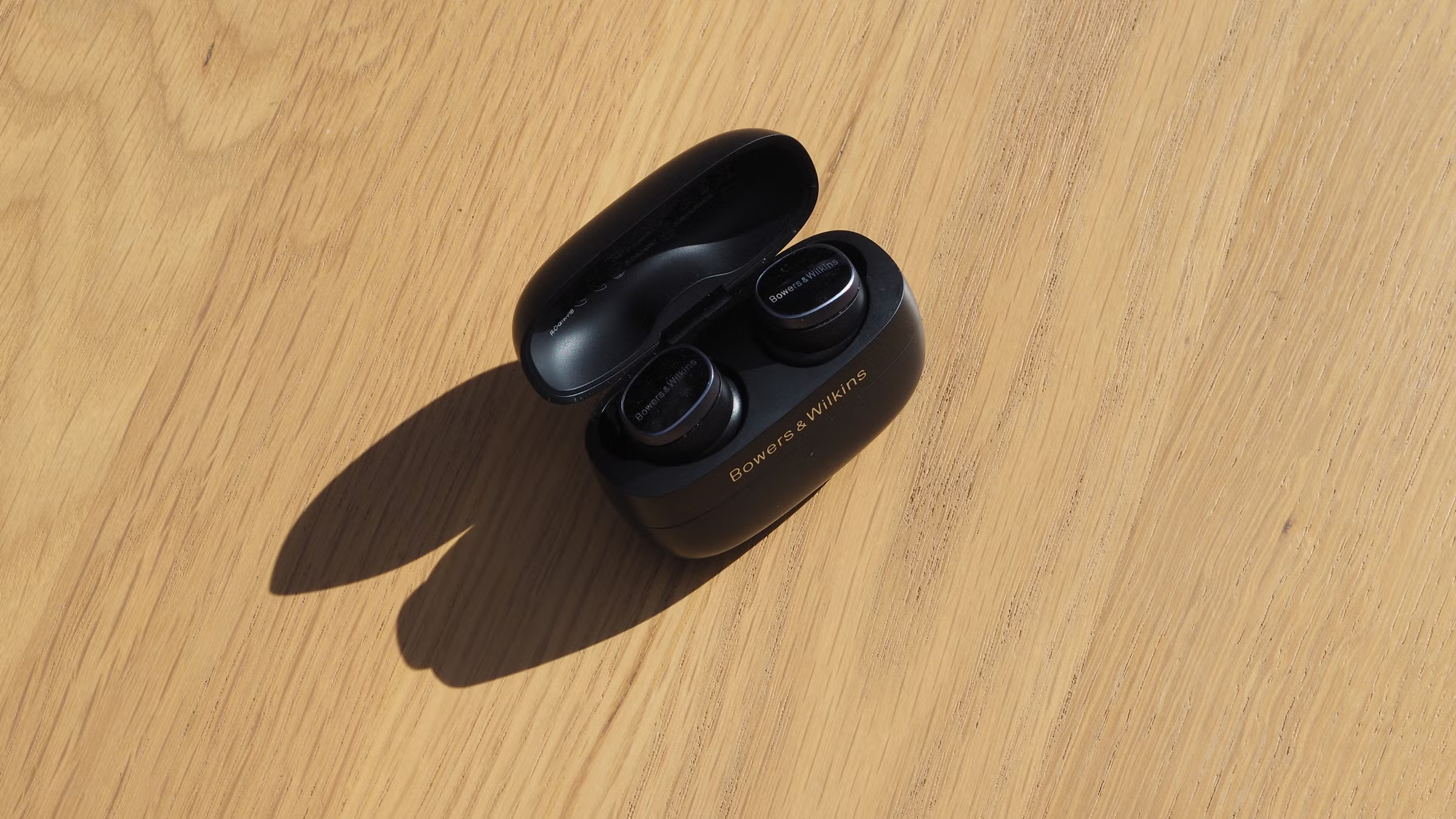
Pros and Cons
+ Pristine sound quality
+ Non-frustrating touch controls
– Not cheap
“The most audiophile worthy of all the earbuds I’ve tested,” one of our veteran reviewers gushed after a month with the Pi8s. Through hours of listening sessions on planes, on trails, on couches, and on city sidewalks, this was the pair that invariably impressed everyone on our test team, with their “incredibly balanced and musical” sound quality.
The $500 price—$250 above Apple’s ubiquitous AirPod Pros and $200 north of the Bose QuietComfort Ultras—means you have to be serious about your music, and about taking good care of your gear. They’re IP54-rated, able to handle sweat and a misty rain, but are not the pair you want to bring to the gym each day. While the four sizes of ear tips help them sit pretty securely and comfortably, they will fall out on occasion. All the same, we won’t discourage you from ever bringing them on a run on a sunny day, where their high-fidelity clarity is sure to put a little more oomph in your step.
The active noise cancellation on the Pi8s is excellent, similar to that on the Bose QCII, with touch controls for toggling between on, off, and transparency mode. The touch controls work better than in most earbuds we’ve seen, with a satisfying light noise that’s akin to a mouse click. We also love the pearlescent finish on the outer surface of the Pi8s, which come in four colors. A robust companion app lets you turn off the touch controls and has a five-band equalizer so you can tweak the sound profile to your liking. Battery life here is an average 6.5 hours, and the charging case holds two additional charges (13.5 hours).
Another nice feature is something called retransmission. This allows you to use the included USB-C-to-3.5mm cord to plug the unit’s charging case into an external device like an in-flight entertainment system and the case will send the signal into the buds, so you’re not stuck listening on that plastic-wrapped pair the flight attendants hand out with the peanuts.
One reviewer reported, “I listened to an album with two double basses—’‘But Who’s Gonna Play the Melody?’ by Christian McBride and Edgar Meyer—and I could hear their fingers and the pull of the bow on the strings in ways I hadn’t before.” That’s a good example of what makes these shine like few have before them.
The Hottest Trend in Sport Earbuds
This year, for the first time in our testing history, open earbud models outnumbered traditional in-ear ones among our test candidates. The open design allows you to hear far more of what’s going on around you, and I’ve been slow to take a liking to them. There’s no doubt that they make a lot of sense for people who run along the roadside or, even more so, cyclists who go anywhere near cars—generally a very bad time to be canceling the noise around you.
Since I live in the desert and rarely pass another living soul on the trails, I don’t prioritize hearing what’s going on around me, and open earbuds will always be challenged to sound as good, or as loud, when they’re handicapped by having to reach your hearing by alternative methods. So for music, they’re not my favorite; for podcasts and audiobooks, I’ve learned to appreciate them.
Open earbuds work in one of two ways: either with the transmitter positioned near your ear canal but not in it (see Skullcandy’s Push 720 Open) or through bone conduction (found in the Shokz Open Swim Pro, above, and another favorite, the H2O Audio TRI 2 Pro), which bypasses your eardrum, sending sound directly to your inner ear by way of your skull bones. More recently, a new design has gotten popular, which I refer to as the clip-on earring style: these put the transmitter right in front of your ear but use a more diminutive design. In addition to this season’s winner from Skullcandy, we’re also fans of models from Bose, Soundpeats, and Shokz.
In the meantime, many closed-ear models these days (see Bowers & Wilkins’ Pi8s) let you employ a transparency (or awareness) mode that enhances ambient sound. This can be a nice in-between solution if your need for awareness isn’t so much life-and-death as it is a courtesy to the runner or biker “on your left.”
How to Choose Earbuds
Earbuds are more like shoes than most other gear categories: so much depends on the right fit. What comfortably fits one person’s ears may not suit another’s, and there’s more to it than size. The internal anatomy of the ear makes certain designs actually sound better to one person than the next. (This is why Bose, Denon, and others have started to include tech that measures your ear shape and customize sound to fit your own anatomy.) If you can’t try them out at a store or borrow them from a friend, it may be best to buy them from a retailer with a good return policy. Once you have them in hand, do some real-world tests with the different tip sizes, and trade them in if you aren’t in love.
If you want to get serious about the perfect fit, consider aftermarket foam ear tips, like these from Comply, or Azla’s SednaEarfit tips, which are made of a snazzy elastomer material that uses your body heat to soften and reshape themselves to mold to your ears.
Also give some thought to which features do it for you: Some people like sleek touch controls, others prefer old-school push buttons; some like to tap for quick pausing, others would rather forgo that feature and pull out one bud to ask for directions, so as to avoid the annoyance of unwanted pauses every time your fingers go near them. And if you live in a rainy climate, be sure to choose ones with an IP (ingress protection) rating ending in 4 or higher (as all the models here do).
Also see: How to Clean Your Earbuds
How We Test Sport Earbuds
- Hours of Testing in 2025: 790
- Number of Earbuds Tested in 2025: 55
- Test Environments: Running, hiking, plane rides, cycling, windsurfing, swimming in Long Island Sound, skiing, rock climbing, HIIT workouts, yardwork, car camping, conference calls, video streaming, noisy coffee shops
- Highest Elevation: 10,152 feet, Leadville, Colorado
- Lowest Elevation: 5 feet underwater in Lake Pleasant, Arizona
- Most Listened-To Tracks: Belle and Sebastian: “I Don’t Know What You See in Me,” Childish Gambino: “Lithonia,” D’Angelo: “Shit, Damn, Motherfucker,” Dijon: “Yamaha,” Drugdealer and Kim Bollinger: “Pictures of You,” Fontaines D.C.: “Favourite,” Kenya Grace: “Strangers,” J Dilla: “Workinonit,” Lady Gaga: “Abracadabra,” Magdalena Bay: “Image,” John Martyn: “Sweet Little Mystery,” Cass McCombs: “Brighter!,” Sinead O’Connor: “Feel So Different,” The O’Jays: “Ship Ahoy,” Prince: “Electric Chair,” Spoon: “Wild,” Thunderegg: “Loyola Dream,” Yumi Zouma: “Powder Blue”
The first thing we do with any earbuds or speakers is attempt to pair them with our phones without consulting the user manual: the quicker, more intuitive, and easier the Bluetooth setup, the more points scored. Then we put them through rigorous hours of testing doing the kinds of things Outside readers do—from dog walks to HIIT workouts, from fireside listening to our day jobs. Our testers, who range in location from Alaska to Berkeley to Aspen to Santa Fe to New York City, spent hours in them, bouncing up and down on trails, treadmills, and trains.
Our team turns in reports on each product tested, providing a score from 1 to 10 for five different measures: sound quality, pairing and connectivity, fit and comfort, rain and drop protection, and user friendliness. Scores are averaged, with more weight given to sound quality and (knowing our audience) how well they stand up to the elements. Note: Battery life estimates in these reviews are based on manufacturer specs; it’s difficult to confirm those numbers, given the time involved and variances among user habits (different volumes, different uses, different functions enabled). Actual results may be 10 to 20 percent lower, judging from averages experienced in general testing.
Meet Our Lead Tester
Will Palmer has been testing gear for 21 years for Outside, where he was managing editor and copy chief for nine years. Based in Santa Fe, he has been a runner since 1984, and while the mile counts have decreased over the years, he’s kept motivated to head out the door on the hottest, coldest, and wettest days by the opportunity to test the best new products—and to commune with the junipers and piñons.